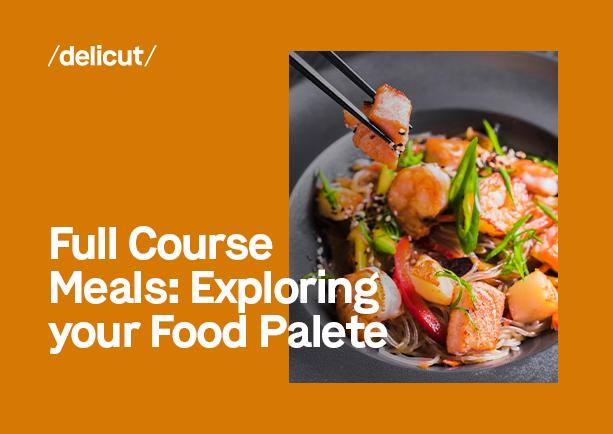Full Course Meals: Exploring Your Food Palate

In the world of fine dining, the full-course meal is considered the ultimate show stopper—a blend of flavours and textures carefully orchestrated to provide a satisfying and memorable dining experience. But what exactly constitutes a full-course meal, and what goes into creating this experience?
To understand the full-course meal, we must first delve into its origins. The concept dates back to medieval times when elaborate feasts were hosted by nobility and royalty. These feasts showcased not only the host's wealth but also their culinary prowess. The meal structure evolved over centuries, influenced by cultural practices and the availability of ingredients.
Here’s how the full-course meal evolved over time -
12-Course Meal: In a 12-course dinner menu, you can expect to indulge in an array of culinary delights, starting with an hors d'oeuvre, followed by an amuse-bouche, soup, appetizer, salad, fish, first main course, palate cleanser, second main course, cheese course, dessert, and concluding with a mignardise.
10-Course Meal: If you opt for a 10-course dinner, your gastronomic journey will encompass an hors d'oeuvre, soup, appetizer, salad, fish, main course, palate cleanser, second main course, dessert, and a delightful mignardise.
9-Course Meal: For a slightly lighter affair, a 9-course dinner menu includes a hors d'oeuvre, soup, appetizer, salad, fish, main course, palate cleanser, dessert, and a finishing touch with a mignardise.
8-Course Meal: An 8-course dinner menu offers a well-balanced culinary experience, featuring a hors d'oeuvre, soup, appetizer, salad, main course, palate cleanser, dessert, and a delightful mignardise.
7-Course Meal: With a 7-course dinner menu, you'll embark on a flavorful journey beginning with a hors d'oeuvre, followed by soup, appetizer, salad, main course, dessert, and a sweet ending with a mignardise.
6-Course Meal: A 6-course dinner menu pares down the extravagance slightly, encompassing a hors d'oeuvre, soup, appetizer, salad, and main course, and concluding with a satisfying dessert.
5-Course Meal: Opting for a 5-course dinner means relishing a hors d'oeuvre, appetizer, salad, and main course, and culminating in a sweet note with a delectable dessert.
4-Course Meal: A 4-course dinner menu simplifies the dining experience, featuring a hors d'oeuvre, appetizer, main course, and a delightful conclusion with dessert.
3-Course Meal: For a more streamlined dining affair, a 3-course dinner menu includes an appetizer, main course, and a sweet finale with dessert.
Let’s unravel the layers of a full 12 course meal.
The Traditional Structure:
A traditional full-course meal typically comprises several courses, each serving a distinct purpose in the overall dining experience. The sequence usually includes:
Hors D'Oeuvres: Traditionally presented during cocktail hour or as guests arrive, hors d'oeuvres consist of convenient, hand-held finger foods designed for easy consumption. Delight your palate with offerings such as goat cheese crostini accompanied by a delectable fig-olive tapenade and savoury zucchini fritters.
Appetizers (Amuse-Bouche):
These bite-sized, palate-teasing morsels serve as a prelude to the main courses. They aim to excite the taste buds and set the tone for the meal.
Soup:
Often served hot, soups provide a comforting transition between the appetizers and the more substantial courses. They can be light and refreshing or hearty and nourishing.
Salad:
A palate-cleansing salad follows the soup, offering a burst of freshness. This course often incorporates a variety of textures and flavours, preparing diners for the main courses.
Main Course:
The heart of the meal, the main course typically features meat or poultry accompanied by a variety of side dishes. This course allows for a rich exploration of flavours and cooking techniques.
Cheese Course:
A selection of cheeses may be presented before or after the main course, providing a savoury interlude. This course is a celebration of craftsmanship and regional diversity in cheese-making.
Dessert:
The grand finale, dessert, brings a sweet conclusion to the meal. It can range from decadent pastries to refreshing fruit-based creations, leaving a lasting impression on the diners.
Coffee and Digestifs:
A cup of coffee or a digestif like brandy or port often concludes the full-course meal. These beverages aid in digestion and provide a final moment of relaxation.
Creating a full-course meal is an art that requires careful consideration of flavours, textures, and presentation. Chefs must balance the richness of each course, ensuring a harmonious progression that keeps diners engaged from start to finish. Key elements in crafting the perfect full-course meal include:
Balance and Contrast:
A well-designed full-course meal achieves a balance between rich and light, sour and sweet, hot and cold. Contrasting flavours and textures create a dynamic and memorable dining experience.
Seasonal and Local Ingredients:
The use of seasonal and locally sourced ingredients not only enhances the freshness of each course but also connects the meal to the region's food identity.
Presentation:
Visual appeal is crucial in a full-course meal. Each dish should be presented with care, showcasing the chef's attention to detail. Thoughtful plating enhances the overall dining experience.
Wine Pairing:
The selection of wines to accompany each course is an essential aspect of a full-course meal. The right pairings enhance the flavours of the food and contribute to the overall enjoyment of the dining experience.
Conclusion:
In a world where fast-paced lifestyles often prioritize convenience over ceremony, the full-course meal stands as a testament to the enduring allure of a meticulously crafted dining experience. From the tantalizing appetizers to the sweet indulgence of desserts, each course plays a vital role in creating a memorable journey for the senses. So, the next time you find yourself at a table set for a full-course meal, take a moment to savour not just the flavours on your plate but the artistry behind the entire culinary experience.
FAQs
1. What is the definition of a full-course meal, and what components typically makeup such a meal?
A full-course meal is a gastronomic experience comprising multiple courses, carefully curated to offer a diverse range of flavours and textures. It typically includes appetizers, soups, salads, main courses, palate cleansers, desserts, and more.
2. How does a full-course meal differ from a regular meal in terms of courses and structure?
Compared to a regular meal, a full-course meal is distinguished by its structured progression of courses. It follows a deliberate sequence, building from lighter to more substantial dishes.
3. Can you explain the traditional sequence of courses in a formal full-course meal?
The traditional sequence involves appetizers, soups, salads, fish, main courses, palate cleansers, and desserts. Each course serves a specific purpose in creating a well-rounded dining experience.
4. Are there variations of full-course meals in different cultures, and if so, what are some examples?
Different cultures offer variations of full-course meals. For instance, French cuisine includes amuse-bouches, while Japanese kaiseki involves a multi-course meal emphasizing seasonality.
5. What etiquette or guidelines should be followed when dining at a formal full-course meal?
When dining at a formal full-course meal, etiquette is crucial. Use proper utensils, follow the host's lead, and pace yourself. Wait for everyone to be served before starting and engage in polite conversation to enhance the overall experience.
Read More :
Prioritizing your Health Top 5 Perfect Meal Ideas for your Health
What is Meal Planning Know the Benefits
The Power of Mindful Eating How to Develop a Healthy Relationship with Food
Exploring Plant Based Protein Foods for a Healthier Diet
The Link Between Diet and Mental Health Foods For a Happy Mind
Related Blogs
Why do most people in the UAE get their calories wrong
Dec 8, 2025 | 6DASH Diet Meal Plan
Nov 11, 2025 | 8Fatty Liver Meal Plan
Oct 31, 2025 | 8Pregnancy Diet Meal Plan
Oct 27, 2025 | 82000 Calorie Meal Plan
Oct 1, 2025 | 8Intermittent Fasting Diet Plan
Sep 5, 2025 | 81000 Calorie Meal Plan
Sep 5, 2025 | 8High-Protein Meal Plans
Sep 5, 2025 | 8How to Choose the Right Meal Plan for Your Fitness Goals
Sep 5, 2025 | 8The GM diet plan: Is it possible to shed fat in just 7 days?
Sep 5, 2025 | 8






